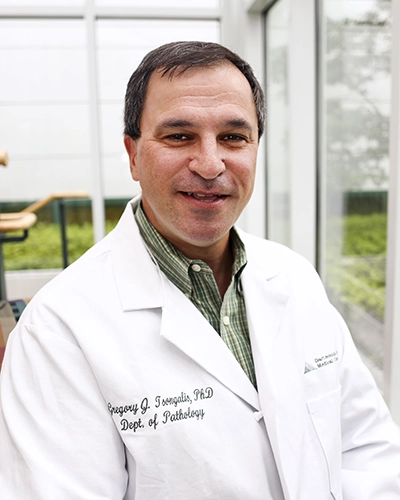

by Gregory J. Tsongalis, PhD
Tue, Apr 16th, 2024 6:33 pm
The College of American Pathologists (CAP) Accreditation Program Molecular Pathology Checklist (v. 08.24.2023) defines controls as “surrogates for patient specimens to monitor the ongoing performance of the entire analytic process in every run.” At a minimum, laboratories should include 3 types of controls in each run for qualitative assays:
However, running, documenting, and monitoring QC results can be a daunting task for laboratories with extensive test menus. In this blog, we discuss various QC perceptions from three different laboratory stakeholders: technologist, manager, and director.
As a clinical molecular diagnostics laboratory, our goal is to provide timely and reliable testing that will impact patient diagnosis and management of disease. A significant part of producing reliable results is being able to assess the accuracy and precision of the test being performed. One of the most significant contributions of any Quality Management program is the implementation of using Quality Control (QC) materials to help answer the following questions:
Given the important role of QC in a clinical testing environment, it may come as a bit of a surprise that performance of QC testing is often met with reservation or reluctance and that acceptability criteria and mitigation can be extremely variable from lab to lab.


Molecular diagnostics has matured to a point where, for many applications, it is considered the standard of care for genetic disease, infectious disease, or cancer testing. In order to accommodate testing for one or more of these areas, laboratories have turned to a variety of molecular techniques including different methods of amplification, microarrays and sequencing.
From a technologist’s perspective, remaining proficient with several different techniques, instruments, and assays can be challenging.
In this scenario, QC are used to:
The data generated from a molecular diagnostic test can range from very simple to highly complex. Yet, the downstream impact on patient management can be profound for either.
From an administrative perspective, QC metrics are the standards to which each clinical test must be held.
QC failures can be due to various pre-analytical and analytical variables and as such must be performed according to regulatory guidelines. While this may seem obvious, there seems to be subjective interpretation of the regulations when it comes to QC and many choices are left at the discretion of the laboratory:
As complex molecular testing can be expensive on a per assay basis and the fact that there is no reimbursement for running controls suggests that running fewer may be better. W. Edwards Deming is known as the father of the quality movement and mastermind of the Toyota Way. His biggest contribution to the healthcare industry, albeit indirectly, was showing that by increasing quality you actually decrease costs. In the clinical laboratory, this requires routine review of QC results to identify any negative trends or performance issues.


As molecular diagnostics continues to grow in scope and practice, more testing is becoming highly automated or generating unprecedented amounts of complex data. From this perspective, QC helps to manage not only the analytical variables of testing but also helps to assess results of testing.
From a laboratory director’s perspective, first and foremost is the concern for patient safety through accurate testing.
In addition, there is the requirement to be sure that the laboratory is compliant with all federal and state regulations, including the performance of QC measures. This may require assessment of laboratory workflows, batch sizing, run schedules, and development of Individualized Quality Control Plans (IQCP). The one-size-fits-all philosophy does not really work in a molecular diagnostics laboratory as every technology is different and different vendor instruments performing similar technologies can be different in performance. Therefore, “at the discretion of the laboratory director”, requires serious consideration of all QC practices in the laboratory.
Regardless of your role in the clinical molecular diagnostics laboratory, measuring and monitoring QC on a regular basis should be a standard of practice. The implications of a molecular result reach far beyond “just a diagnosis” and can impact the medication a patient receives, patient management strategies and risk levels for family members.
Dr. Tsongalis is the Director of Clinical Genomics and Advanced Technology (CGAT) and the Vice Chair for Research for the Department of Pathology and Laboratory Medicine at Dartmouth Hitchcock Health System, as well as a Professor of Pathology at Geisel School of Medicine at Dartmouth College.
Dr. Tsongalis received his BS from the University of Massachusetts at Amherst, where he majored in zoology and chemistry, and an MHS from Quinnipiac College as a PA in Pathology. He received his PhD in Pathology from the University of Medicine and Dentistry of New Jersey, where he studied human DNA repair mechanisms in xeroderma pigmentosum and Fanconi anemia. He completed his post-doctoral training in clinical chemistry in the Department of Pathology at the University of North Carolina Chapel Hill, where he was first exposed to molecular diagnostics and explored the intricacies of the nuclear matrix and its role in the regulation of DNA replication through interactions with origins of replication. After completing this NIEHS-funded training program, he joined the Clinical Laboratories Division of Clinical Chemistry at the University of North Carolina, developing assays for in situ amplification and diagnostic testing for fragile X syndrome.
Throughout his career, Dr. Tsongalis has been striving to apply molecular techniques to diagnostic questions that are not adequately addressed by traditional laboratory methods and has challenged the boundaries between clinical pathology and anatomic pathology, applying state-of-the-art molecular techniques to improve patient management through precision medicine. He has received numerous awards for his contributions to laboratory science, is a member of many professional organizations, and has given presentations at local, national, and international meetings. He has authored or co-authored many textbooks and peer-reviewed publications in the field of molecular pathology. He remains committed to the development and application of molecular-based diagnostic assays for the clinical laboratory.

Gregory J. Tsongalis, PhD